
|
September 5th, 2007
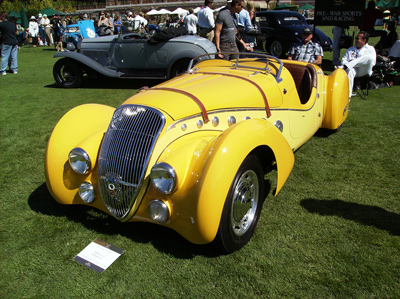
1938 Peugeot 402 Darl'mat, owned by Chuck Swimmer and Armando Flores. Approximately 100 cars were made, about 30 are known to exist.
|
Monterey Weekend 2007
Story and Photos by Brandy Elitch
When it comes to describing the Monterey Week, my favorite comment is from an article in a recent Wall Street Journal, comparing Monterey with another event occurring at the same time - the Detroit Woodward Avenue Dream Cruise. The Journal said that the two events are "separated by the number of digits in the personal net worth of the average attendee," and that about sums it up.
Monterey Historics
Each year, a different marque is featured, attracting the best examples from all over the world, along with the drivers originally associated with it. What is really amazing is how Steve Earle can keep pulling it off year after year, and still keep it fresh and exciting. This year, Earle threw us a curve ball. Now the only question is: why didn't this happen sooner? Instead of Jags or Alfas or Chaparrals, the feature was "A Salute to the Indy Roadsters."
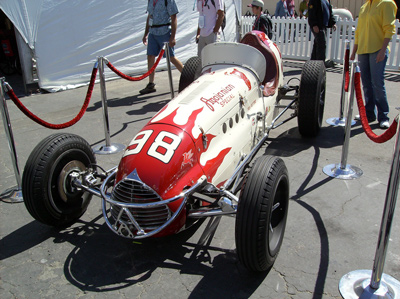
Prior to 1952, most Indy cars were similar to this sprint car. Then along came Frank Kurtis who revolutionized Indy cars.
|
Who would have guessed that so many of them have survived, or that so many of them have been restored to perfection, and can make a creditable appearance on the track? Of course, unlike their road race brethren, Indy cars don�t need four speed gearboxes or much in the way of brakes, but those four cylinder Offys sure sound great. They were built with the same creativity, passion, skill, and excitement as any of the other marques that have proceeded them down the straight at Laguna Seca.
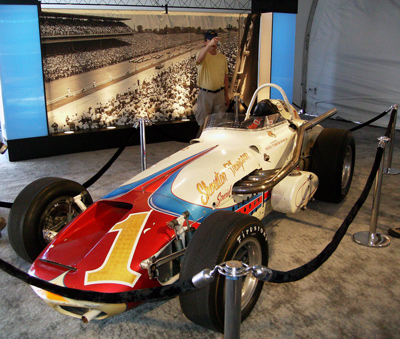
One of the last of the Kurtis/Watson roadsters, which by 1965 were no longer competitive.
|
Back in the forties and fifties, most car owners could not afford to build a car just for one race a year, so until Frank Kurtis started making these cars, the owners used the same �Sprint� cars at Indy that they were campaigning the rest of the year at the dirt tracks. It wasn't until 1953 that the purpose built "roadster" came into its own, and of course dominated Indy, in Kurtis and later Watson guise, until the British invasion of the early sixties. Like the dinosaurs, they disappeared quickly, never to return, until now.
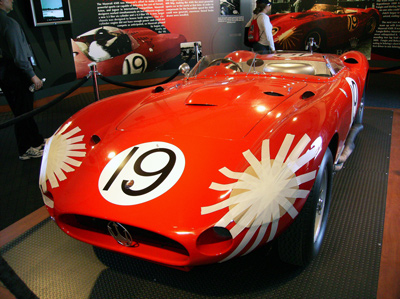
Maserati was featured in a special retrospective at the Rolex Tent at Laguna Seca: the race cars of 1957. This is the car that Fangio was to have raced at the Cuban GP.
|
The featured marque is only one part of the Historics, because there are many, many other fantastic racecars in the paddock, and even the parking lot is worth a visit, with areas staked out by participating car clubs. But there was one thing that was new this year, and it was, for me, the highlight of the whole weekend. As I walked over the bridge and entered the track at 8 am on Saturday morning, I heard the PA system announce that the first hundred people to get to the Rolex tent would get a ticket for an autograph session with nine famous drivers. I collect driver's autographs, so naturally I sprinted over to where a long line was forming, just in time to be #95.
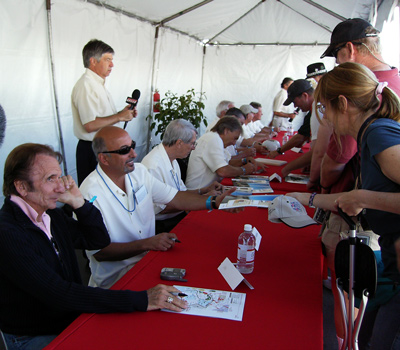
Line up of famous race drivers included Vic Elford, Al Unser, and Emerson Fittipaldi.
|
Then, an hour later, I was waving my poster at Derek Bell, Vic Elford, Emerson Fittipaldi, Parnelli Jones, Bobby Rahal, Johnny Rutherford, Al Unser, Bobby Unser, and Ove Andersson. Somebody went to a lot of work to put this together, and it was outstanding. Signed poster in hand, I commenced to wander aimlessly and contentedly through the paddock, blissfully unaware of incurring of a major league sunburn, and not caring either.
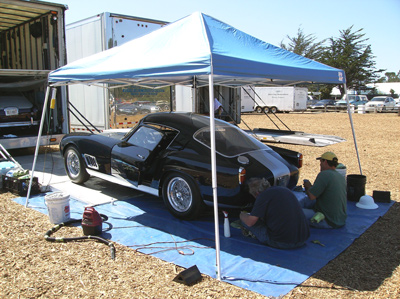
Never ending cleaning, before, during and after an event.
|
The Quail
Since 1974, Concorso Italiano had put on a show for Italian cars (which excluded Ferraris) at the high-class Quail Lodge Resort in Carmel Valley. By 2005, after allowing Ferraris, it got so large that it made sense to move it to another part of Fort Ord. The Quail location became the venue for a new event called �A Motorsports Gathering.�
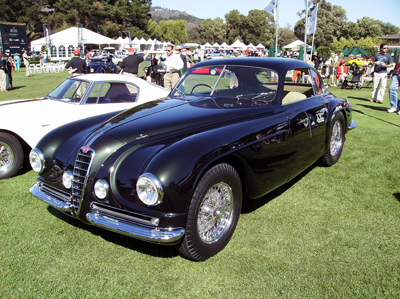
1949 Alfa Romeo Villa d'Este Coupe, owned by Timothy Walker. The name was given when this model won a prestigous concours at the Villa d'Este at Lake Como in 1948. This car was originally delivered to a member of the Egyptian royal family.
|
The idea behind the Quail was that it would be small and exclusive: only 100 cars would be shown, and a limited number of tickets would be printed (this year only 3000 and they sold out quickly). The Lodge and Golf course is owned by the Peninsula Hotel Company, part of the Hong Kong and Shanghai Hotel business. You know that you are in a different kind of car show when some of the features are the Land Rover Driving School, a golf academy, and a jewelry and diamond boutique on the show field, and the show is characterized by the organizers as "a day long culinary gourmet journey with world class food and wine, utilizing a fresh, local, and sustainable food philosophy."
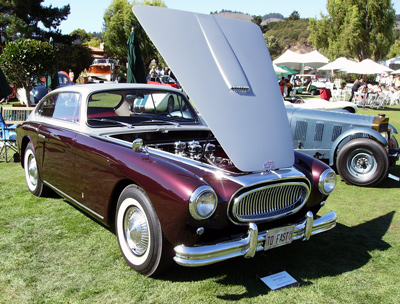
Cunningham made a very limited number of road cars. Here is the C3, a Vignale bodied coupe with a 220hp Chrylser engine.
|
The features this year were the hundredth birthday of Briggs Cunningham, the 75th Anniversary of the Monte Carlo Rally, and the 50th Anniversary of the Ferrari 250 GT Series I Cabriolet (of which 40 were built from 1957-9).
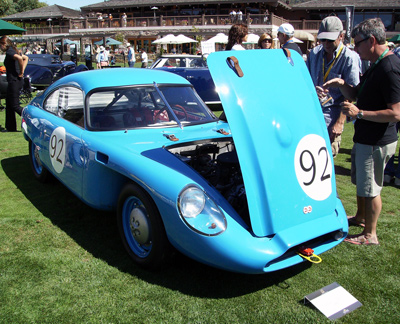
1959 Deutsch-Bonnet HBR5, owned by Arthur and Nevada Cook, CA.
About 800 D-B's were built before the end in 1961. This car is one of 5 built.
|
When you are limited to only a hundred cars, and charging $200 a ticket, people expect to be entertained, and they were not disappointed. Of course, most of the elegant cars were French and Italian, but what an eclectic group. And, while I have seen most of them elsewhere over the years, there was one Italian bodied car that I had never seen, not even in a picture, and which, for me, was the tour de force of the show: a Packard. Yes, you read it right.
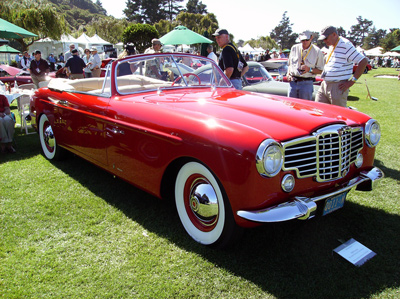
1948 Packard, owned by Ralph Marano, NJ, Vignale body, the only one built.
|
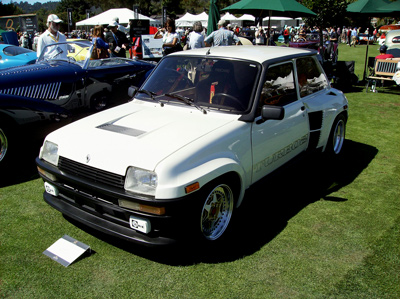
1984 Renault 5 Turbo II, owned by Paul Kramer, CA. This model won the Monte Carlo Rally in 1984, and was World Rally Champion.
|
Vignale re-bodied a 1948 "bathtub" Packard and created the car that Packard, should have produced before the 1948 Cadillacs took the styling crown away for the last time. Only one was made. The car was red with a white interior, not the color scheme I would have chosen for this elegant car - in fact, probably the obverse. But who's quibbling - it was spectacular.
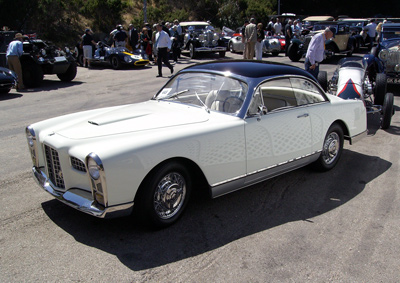
1955 FACEL FV1, sold at $102k.
|
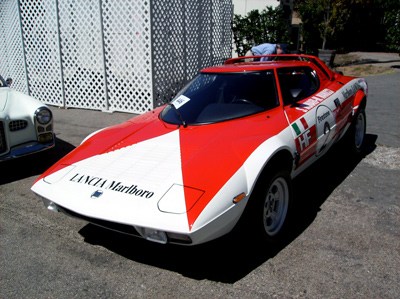
No kit car this, but a true Stratos, which sold for $131,000 at Bonham's.
|
Adjacent (SP) to the show was the Bonhams auction tent, was particularly taken by an all-white FACEL Vega,actually an
FV1 coupe, a truly exceptional restoration, and for once, the all-white color scheme worked. By the way, who knows what the designation "HK 500" really stands for? - a prize for the first correct answer.
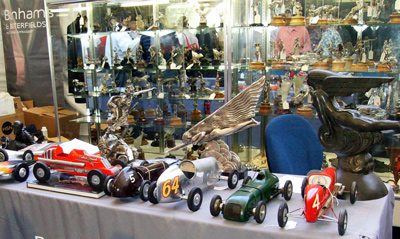
Automobilia at the Bonham's tent.
|
Much too much
There are so many activities in Monterey and Carmel during the Historics that it would be physically impossible to attend all of them: auctions, car club meetings, tours, special sales of automobilia, and more.
I did visit the "Retroauto" tent to see my friend Mike Rabin, who makes reproductions of the custom wheel discs fitted to wire wheels for cars made between the wars, and as I was debating with myself whether or not to pay $150 for the new Norman Dewis book on Jaguar, Jay Leno sat down next to me and started perusing another book; I guess I should have looked to see what he was reading.
Elsewhere in the tent, someone was making a "recreation" of the Figoni Delahaye. To quote from their catalog: "The carbon fiber Sultan starts in the $350,000 range, and the aluminum bodied Delahayes, Bugattis, etc. start at $500,000. Special options, such as gold plated exterior trim, crocodile or other exotic hide interior fabrics are available."
I am not making this up. But what would you expect - it's Monterey.
|

|



